The Hydrogen Cluster Target at the ESR

1GSI, Darmstadt, Germany
2IKF, University of Frankfurt, Germany
The Hydrogen Cluster Target at the ESR |

|
|
| 1GSI, Darmstadt, Germany |
| The internal gasjet-target of the ESR storage ring provides an important tool for a broad range of atomic as well as nuclear physics experiments. In the reaction chamber the stored ions cross a perpendiculary oriented molecular or atomic supersonic gas-jet. The jet is produced by expanding a gas through a Laval nozzle of 0.1mm in diameter. To meet the UHV requirements of the ESR, the actual set-up consists of an injection and a dump part, both separated by skimmers in four stages of a differential pumping system. The diameter of the gas-jet in the reaction chamber amounts to about 5 mm [1]. To operate the target with very different gas species at optimum performance, the distance of the nozzle to the first skimmer can be adjusted via remote control. Typical distances between nozzle and first skimmer amount to 30 mm for light gases and 60 mm for the heavy gases. As a further and new option, the nozzle can now be cooled with liquid nitrogen to a temperature of 77 K. This leads to clusters for light gases especially for hydrogen. As a consequence, target density is increased by more than two orders of magnitude. The input pressure can be varied from 100 mbar to 20 bar, depending on the nozzle geometry and the gas species used. Target gases currently available are: H2, N2, CH4, Ar, Kr and Xe. For the expensive noble gases such as kryton or xenon, a recycling system is used, which cleans and recompresses the gas. |
Schematic Picture of the Gasjet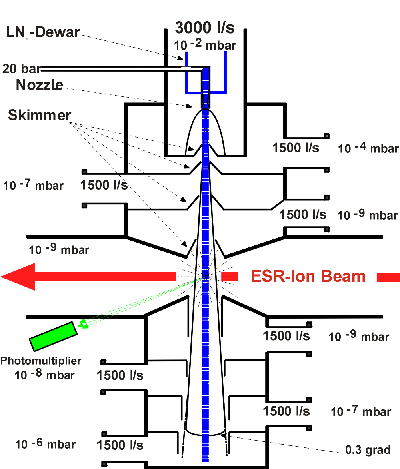 Schematic picture of the ESR internal target. The jet consists of four stages at the injection and four at the dump side. The stages were pumped differentially with turbo pumps. (from [2]) |
Photo of the Inner Part of the Gasjet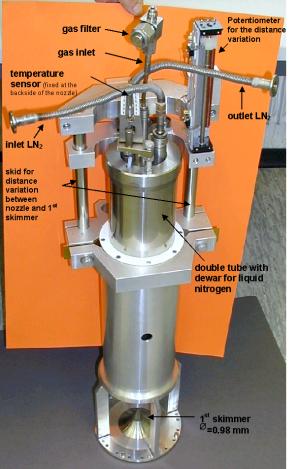 |
||||||||||||||||||
Achievable Target Densities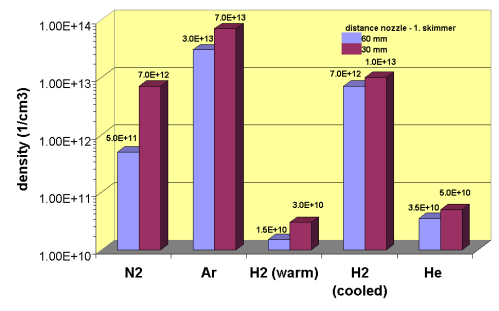 |
Capture Processes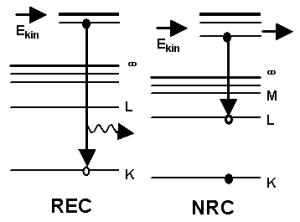 |
||||||||||||||||||
Target Parameters
The Laval Nozzle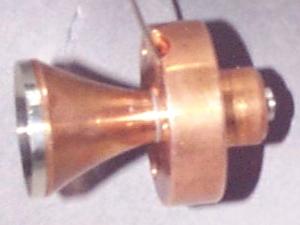
|
The Influence of Nozzle Cooling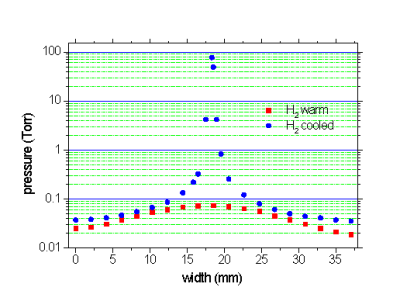 Due to the cooling of the nozzle and the gas the hydrogen is building clusters and the density of the jet increases. The curves were measured with a stagnation tube in adistance of 30 mm behind the nozzle. Due to the cooling of the nozzle and the gas the hydrogen is building clusters and the density of the jet increases. The curves were measured with a stagnation tube in adistance of 30 mm behind the nozzle.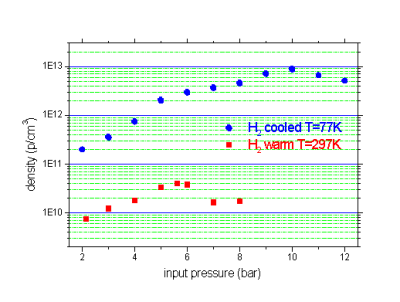 The clustering of the hydrogen gas results in tagertd density which is more than two orders of magnitude higher than the uncooled jet. The clustering of the hydrogen gas results in tagertd density which is more than two orders of magnitude higher than the uncooled jet.
|
Electron Capture Cross Sections and Lifetimes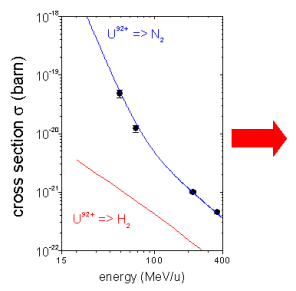 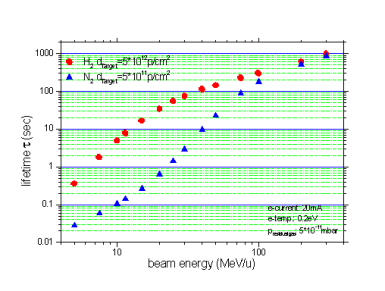 For abre ions, the two most important charge-exchange processes in the gas-jet are the Radiative Electron Capture (REC) and the Non Radiative Capture (NRC) [4]. While the REC process scales with ZP5 * ZT / v5/2, the scaling for NRC follows a ZP5 * ZT5 / v11 dependence. This means that the REC is dominant for high energies and for low-Z targets. The NRC dominates for low energies and high-Z targets. The absolute electron capture cross-sections are shown on the left side of the figure. On the right figure an estimate fo the beam lifetimes of an U92+-ion beam is shown for various beam energies. For this purpose also recombination in the cooler sections as well as charge exchange in the residual gas of the storage ring was taken into account. The blue triangles belong to collisions with nitrogen gasjet (density: 5*1011 p/cm2) and the red dots reflect lifetime dependence for a hydrogen cluster-target with an area density of 5*1012 p/cm2. For abre ions, the two most important charge-exchange processes in the gas-jet are the Radiative Electron Capture (REC) and the Non Radiative Capture (NRC) [4]. While the REC process scales with ZP5 * ZT / v5/2, the scaling for NRC follows a ZP5 * ZT5 / v11 dependence. This means that the REC is dominant for high energies and for low-Z targets. The NRC dominates for low energies and high-Z targets. The absolute electron capture cross-sections are shown on the left side of the figure. On the right figure an estimate fo the beam lifetimes of an U92+-ion beam is shown for various beam energies. For this purpose also recombination in the cooler sections as well as charge exchange in the residual gas of the storage ring was taken into account. The blue triangles belong to collisions with nitrogen gasjet (density: 5*1011 p/cm2) and the red dots reflect lifetime dependence for a hydrogen cluster-target with an area density of 5*1012 p/cm2. |
Pressure as a Function of the Distance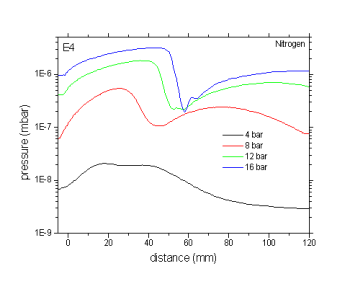 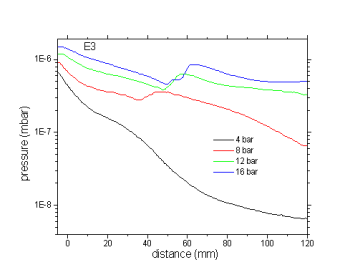 The pressure in the different stages of the gasjet in dependence of the distance between nozzle and 1st skimmer for different stagnation pressures. The pressure in the different stages of the gasjet in dependence of the distance between nozzle and 1st skimmer for different stagnation pressures. |
Target Density during the Experiment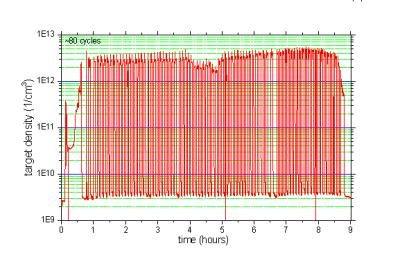 |
X-ray Spectra of 25 MeV/u Pb82+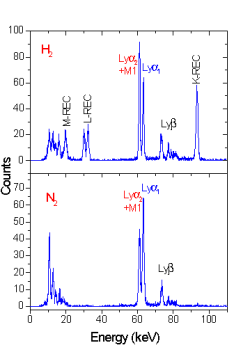 Typical x-ray spectra recorded at the jet-target at an observation angle of 150° for declerated Pb82+ ions at an energy of 25 MeV/u. For the upper spectrum the H2 cluster-target was used wheras the spectrum in the lower part refers to collisions with N2 molecules. The data were taken during a beam time in April 1999 [3]. Typical x-ray spectra recorded at the jet-target at an observation angle of 150° for declerated Pb82+ ions at an energy of 25 MeV/u. For the upper spectrum the H2 cluster-target was used wheras the spectrum in the lower part refers to collisions with N2 molecules. The data were taken during a beam time in April 1999 [3]. |
Profile of the Gasjet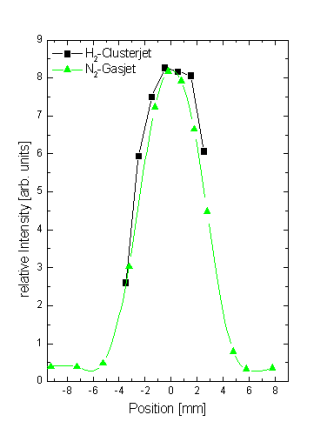 Comparison of the jet profiles of a N2-gasjet and a H2-clusterjet. The profiles where measured by scanning the jet with an ion-beam. In both cases an U92+-ion beam with a velocity of about 300 MeV/u was used. Comparison of the jet profiles of a N2-gasjet and a H2-clusterjet. The profiles where measured by scanning the jet with an ion-beam. In both cases an U92+-ion beam with a velocity of about 300 MeV/u was used. |
Literature:[1] A. Gruber et al., NIM A282 (1989) 87-93[2] H. Reich et al., Nucl. Phys. A626 (1997) 417c-425c [3] A. Krämer et al., to be published (2000) [4] Th. Stöhlker et al., Phys. Rev. A 58 (1998) 2043-2050 |